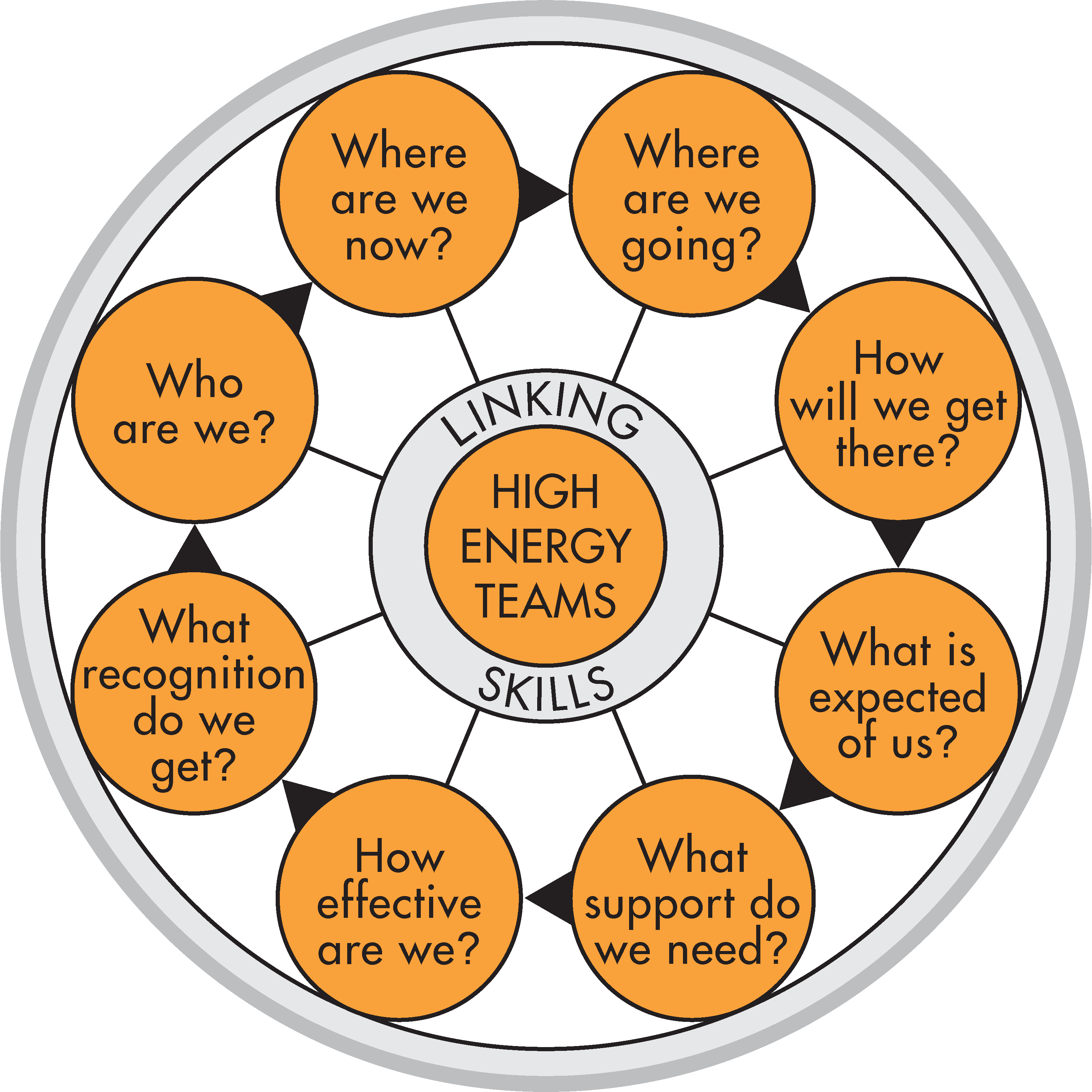High-Energy Teams
Creating a high-energy, high-performance team starts with addressing eight fundamental areas that shape team success. These include understanding identity and purpose, assessing current performance, setting direction, planning execution, clarifying expectations, identifying support needs, measuring effectiveness, and recognizing contributions. Together, they form the foundation of the High-Energy Teams (HET) Model, a research-based framework from Team Management Systems.

Eight strategic questions of the High-Energy Teams Model
The HET Model promotes a culture of continuous formative assessment, enabling teams to track progress and recalibrate every six months. This regular cadence of review ensures ongoing alignment, strengthens accountability, and sustains employee engagement by turning insights into actionable improvements.
1. Who Are We?
Understanding individual strengths, work values, risk orientation, and team role preferences creates trust and collaboration. Teams thrive when differences are harnessed rather than avoided.
2. Where Are We Now?
Evaluate team balance, risk appetite, and values alignment. Use a SWOT analysis to understand current capabilities, spot gaps, and ensure resources are in place to reach your goals.
3. Where Are We Going?
Align team goals with the organizational mission. A shared team purpose statement provides clarity, energizes action, and defines outputs and outcomes.
4. How Will We Get There?
Strategic planning begins with identifying the critical types of work needed. Action plans, objectives, and performance indicators help teams move from vision to results.
5. What Is Expected of Us?
Clarity around roles, responsibilities, and ground rules is key to team success. High-performance teams define expectations and build accountability structures.
6. What Support Do We Need?
Effective teams regularly assess their support needs. This includes training, coaching, mentoring, and systems that enable continuous team learning.
7. How Effective Are We?
Formative assessment helps teams benchmark their performance, conduct reviews, and implement improvement strategies that avoid complacency.
8. What Recognition Do We Get?
Recognition sustains motivation. High-energy teams celebrate achievements through feedback, rewards, and promotion systems that make members feel valued.
Linking Skills
The processes that ensure all eight questions are integrated and coordinated are known as 'linking'. Team members and particularly the team leader need to be effective at a whole range of Linking Skills.
When all these strategic issues have been addressed to the satisfaction of the team, the team will be in a 'high energy' state ready to work optimally to deliver excellent performance.
Track Team Energy with Team Signals
The Team Signals Report allows team members to assess both the importance of these strategic issues and their satisfaction with how well each has been addressed. This data-driven approach offers a holistic view of team effectiveness and employee engagement, guiding actionable improvements.
July
Webinar
22 to 23 | Team Management Profile (TMP) Accreditation
Webinar | US | More about Team Management Profile (TMP) (Virtual)
Open
Webinar
30 to 31 | Team Management Profile (TMP) Accreditation
Webinar | NZ | More about Team Management Profile (TMP) (Virtual)
Open
August
Webinar
07 | Opportunities-Obstacles Quotient (QO2) Profile Accreditation
Webinar | AU | More about Opportunities-Obstacles Quotient (QO2) Profile
Open
Webinar
12 to 13 | Team Management Profile (TMP) Accreditation
Webinar | UK | More about Team Management Profile (TMP) (Virtual)
Open
Public Workshop
21 to 22 | Akkreditierungsseminar für das Team Management Profil
Public Workshop | GE | More about Team Management Profile (TMP) (Public)
Open
Webinar
21 | Window on Work Values (WoWV) Accreditation
Webinar | AU | More about Window on Work Values (WoWV) Profile
Open
Webinar
21 | Window on Work Values Profile Accreditation
Webinar | UK | More about Window on Work Values (WoWV) Profile
Open
Webinar
26 to 27 | Team Management Profile (TMP) Accreditation
Webinar | NZ | More about Team Management Profile (TMP) (Virtual)
Open
Webinar
26 to 28 | Team Management Profile (TMP) Accreditation
Webinar | AU | More about Team Management Profile (TMP) (Virtual)
Open
Webinar
27 | Window on Work Values Profile Accreditation
Webinar | US | More about Window on Work Values (WoWV) Profile
Open
September
Webinar
04 | Opportunities-Obstacles Quotient (QO2) Profile Accreditation
Webinar | AU | More about Opportunities-Obstacles Quotient (QO2) Profile
Open
Public Workshop
09 to 10 | Team Management Profile (TMP) Accreditation (South Korea)
Public Workshop | KR | More about Team Management Profile (TMP) (Public)
Open
Webinar
09 to 10 | Team Management Profile (TMP) Accreditation
Webinar | UK | More about Team Management Profile (TMP) (Virtual)
Open
Webinar
09 to 11 | Team Management Profile (TMP) Accreditation
Webinar | AU | More about Team Management Profile (TMP) (Virtual)
Open
Webinar
17 to 18 | Team Management Profile (TMP) Accreditation
Webinar | US | More about Team Management Profile (TMP) (Virtual)
Open
Webinar
18 | Window on Work Values (WoWV) Accreditation
Webinar | AU | More about Window on Work Values (WoWV) Profile
Open
Webinar
23 | Opportunties-Obstacles Quotient (QO2) Profile Accreditation
Webinar | UK | More about Opportunities-Obstacles Quotient (QO2) Profile
Open
Webinar
23 | Opportunties-Obstacles Quotient (QO2) Profile Accreditation
Webinar | US | More about Opportunities-Obstacles Quotient (QO2) Profile
Open
Webinar
25 to 26 | Akkreditierungsseminar für das Team Management Profil
Webinar | GE | More about Team Management Profile (TMP) (Virtual)
Open
October
Webinar
02 | Opportunities-Obstacles Quotient (QO2) Profile Accreditation
Webinar | AU | More about Opportunities-Obstacles Quotient (QO2) Profile
Open
Webinar
07 to 08 | Team Management Profile (TMP) Accreditation
Webinar | NZ | More about Team Management Profile (TMP) (Virtual)
Open
Webinar
08 to 09 | Team Management Profile (TMP) Accreditation
Webinar | UK | More about Team Management Profile (TMP) (Virtual)
Open
Webinar
16 | Window on Work Values Profile Accreditation
Webinar | UK | More about Window on Work Values (WoWV) Profile
Open
Webinar
16 | Window on Work Values (WoWV) Accreditation
Webinar | AU | More about Window on Work Values (WoWV) Profile
Open
Webinar
21 to 23 | Team Management Profile (TMP) Accreditation
Webinar | AU | More about Team Management Profile (TMP) (Virtual)
Open
Public Workshop
22 | Team Management Profile Accreditation
Public Workshop | UK | More about Team Management Profile (TMP) (Public)
Open
Webinar
22 to 23 | Team Management Profile (TMP) Accreditation
Webinar | US | More about Team Management Profile (TMP) (Virtual)
Open
Public Workshop
23 to 24 | Akkreditierungsseminar für das Team Management Profil
Public Workshop | GE | More about Team Management Profile (TMP) (Public)
Open
November
Webinar
04 to 05 | Team Management Profile (TMP) Accreditation
Webinar | UK | More about Team Management Profile (TMP) (Virtual)
Open
Webinar
06 | Opportunities-Obstacles Quotient (QO2) Profile Accreditation
Webinar | AU | More about Opportunities-Obstacles Quotient (QO2) Profile
Open
Webinar
11 to 12 | Team Management Profile (TMP) Accreditation
Webinar | NZ | More about Team Management Profile (TMP) (Virtual)
Open
Webinar
11 to 13 | Team Management Profile (TMP) Accreditation
Webinar | AU | More about Team Management Profile (TMP) (Virtual)
Open
Webinar
12 to 13 | Akkreditierungsseminar für das Team Management Profil
Webinar | GE | More about Team Management Profile (TMP) (Virtual)
Open
Webinar
12 | Opportunties-Obstacles Quotient (QO2) Profile Accreditation
Webinar | UK | More about Opportunities-Obstacles Quotient (QO2) Profile
Open
Webinar
12 | Opportunties-Obstacles Quotient (QO2) Profile Accreditation
Webinar | US | More about Opportunities-Obstacles Quotient (QO2) Profile
Open
Webinar
19 to 20 | Team Management Profile (TMP) Accreditation
Webinar | US | More about Team Management Profile (TMP) (Virtual)
Open
Webinar
20 | Window on Work Values (WoWV) Accreditation
Webinar | AU | More about Window on Work Values (WoWV) Profile
Open
December
Public Workshop
04 to 05 | Akkreditierungsseminar für das Team Management Profil
Public Workshop | AS | More about Team Management Profile (TMP) (Public)
Open
Webinar
04 to 05 | Team Management Profile (TMP) Accreditation
Webinar | UK | More about Team Management Profile (TMP) (Virtual)
Open
Webinar
09 to 11 | Team Management Profile (TMP) Accreditation
Webinar | AU | More about Team Management Profile (TMP) (Virtual)
Open
Webinar
09 | Window on Work Values Profile Accreditation
Webinar | UK | More about Window on Work Values (WoWV) Profile
Open
Webinar
09 | Window on Work Values Profile Accreditation
Webinar | US | More about Window on Work Values (WoWV) Profile
Open
Webinar
10 | Opportunities-Obstacles Quotient (QO2) Profile Accreditation
Webinar | AU | More about Opportunities-Obstacles Quotient (QO2) Profile
Open
Public Workshop
11 to 12 | Akkreditierungsseminar für das Team Management Profil
Public Workshop | GE | More about Team Management Profile (TMP) (Public)
Open
Webinar
16 to 17 | Team Management Profile (TMP) Accreditation
Webinar | NZ | More about Team Management Profile (TMP) (Virtual)
Open
Webinar
18 | Window on Work Values (WoWV) Accreditation
Webinar | AU | More about Window on Work Values (WoWV) Profile
Open

